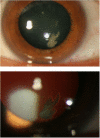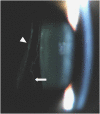Stickler syndrome, ocular-only variants and a key diagnostic role for the ophthalmologist
- PMID: 21921955
- PMCID: PMC3213659
- DOI: 10.1038/eye.2011.201
Stickler syndrome, ocular-only variants and a key diagnostic role for the ophthalmologist
Abstract
The entity described by Gunnar Stickler, which included hereditary arthro-ophthalmopathy associated with retinal detachment, has recently been recognised to consist of a number of subgroups, which might now more correctly be referred to as the Stickler syndromes. They are the most common clinical manifestation of the type II/XI collagenopathies and are the most common cause of inherited rhegmatogenous retinal detachment. This review article is intended to provide the ophthalmologist with an update on current research, subgroups, and their diagnosis together with a brief overview of allied conditions to be considered in the clinical differential diagnosis. We highlight the recently identified subgroups with a high risk of retinal detachment but with minimal or absent systemic involvement--a particularly important group for the ophthalmologist to identify.
Figures









References
-
- Stickler GB, Belau PG, Farrell FJ, Jones JD, Pugh DG, Steinberg AG, et al. Hereditary progressive arthro-ophthalmopathy. Mayo Clin Proc. 1965;40:433–455. - PubMed
-
- Stickler GB, Pugh DG. Additional observations on vertebral anomalies, a hearing defect, and a report of a similar case. Mayo Clin Proc. 1967;42:495–500.
Publication types
MeSH terms
Substances
Supplementary concepts
LinkOut - more resources
Full Text Sources
Medical

